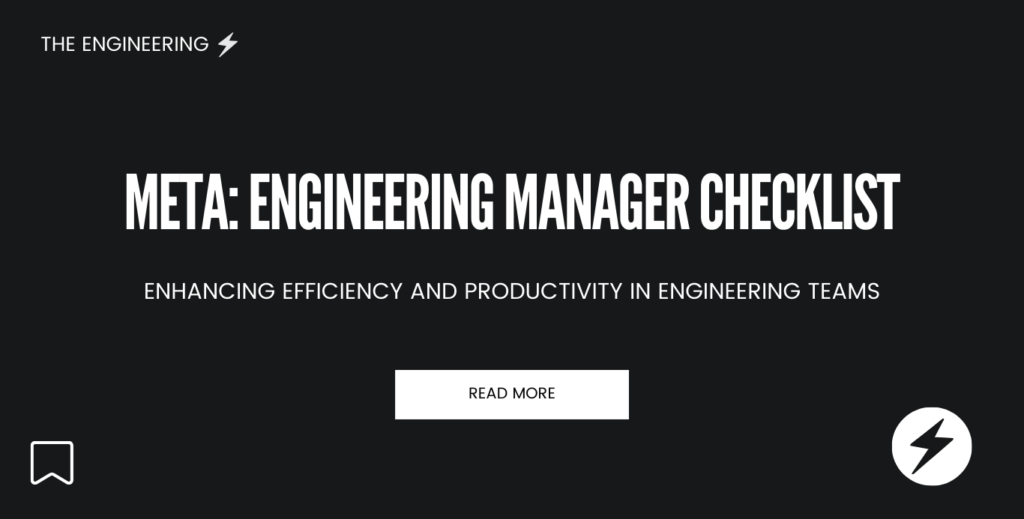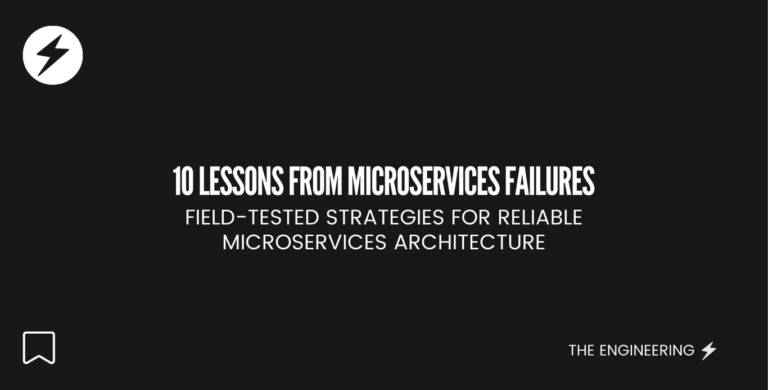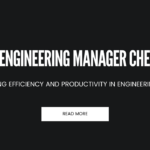
Introduction
In the fast-paced world of technology, the role of an Engineering Manager (EM) is pivotal. An EM oversees the engineering team’s day-to-day operations and ensures that the organization’s strategic goals are seamlessly integrated with the team’s output. A checklist for an EM is not just a set of tasks; it’s a roadmap to effective management, leadership, and governance. This article will explore why an EM’s checklist is crucial and how to use it effectively.
Table of contents
Understanding the Role of an EM
Before we get into the checklist, let’s understand what an EM does. EMs are responsible for many functions, from managing projects, people, and processes to fostering innovation, ensuring quality, and delivering results. They act as a bridge between the technical team and other departments, ensuring collaboration and communication.
In Meta, an Engineering Manager could wear many hats; while their main focus (P0) is supporting people, they might need to jump into different fires as part of their day-to-day role. The role of an EM could be pretty fluid, depending on the team and organization they are. For example, a team with no PM would require an EM to step into that role and set up the strategy and direction for the team. That still depends on the team’s maturity, i.e. a well-established team would have some inertia and a clear set of projects. In contrast, a newly created team would need significantly more support, similar to Tuckman’s stages.
For this post, we can assume a classic example of an engineering team of 5-6 engineers operating in a mature organization with a clear roadmap and set of goals.
First and foremost, an EM should focus on establishing rapport with their direct reports. This would be crucial in driving and aligning the team and setting clear responsibilities and direction. Identifying people’s strengths and working style is equally important, this helps on matching projects and better supporting people’s growth. Getting to know the domain and existing goals and roadmaps and deep-diving into the respective areas will help bring strong leadership and representation to the overall team.
Why is a Checklist Important?
Clarity and Direction
A checklist clearly outlines the actions and steps needed to achieve specific goals. It helps break down complex projects into manageable tasks, ensuring nothing is overlooked.
Prioritization and Focus
With so many responsibilities, EMs must prioritize tasks. A checklist helps identify urgent and essential tasks, allowing EMs to focus their energy where it’s most needed.
Consistency and Accountability
Checklists create a standard task-performing method, which is crucial in maintaining quality. They also hold team members accountable for their responsibilities, tracking progress and completion.
Efficiency and Time Management
A well-structured checklist can save time by preventing redundant tasks and streamlining processes. It is a quick reference guide for EMs to manage their time effectively.
Components of an EM’s Checklist
An EM’s checklist should cover several domains, each tailored to different aspects of the team’s growth and project lifecycle. Here are some key components:
Pre-team Formation
This involves defining the mission, roles, and hiring plan. It ensures that the team’s structure aligns with the organization’s objectives and has clear directions.
Recruitment and Onboarding
Effective recruitment strategies, clear job descriptions, and structured onboarding processes ensure that new hires are well-equipped to contribute meaningfully to the team.
Team Development and Training
A section dedicated to ongoing learning and development keeps the team updated with the latest tech trends and best practices, enhancing their skills and the company’s competitive edge.
Operational Excellence
Setting up efficient workflows, implementing agile methodologies, and ensuring compliance with standards are the backbones of a successful engineering operation.
Communication / Roles & Responsibilities
Clear communication protocols are vital for synchronization across various levels of the organization and successful project delivery.
Goal Setting
An EM can drive the team to deliver impactful results aligned with broader business objectives by setting measurable and achievable goals.
Cultural Integration
Promoting a healthy team culture and integrating new hires into this culture is essential for long-term success and employee retention.
Review and Adaptation
Regular reviews and the flexibility to adapt to new challenges make a team resilient and future-proof.
EM Checklist
| Section | Description | Details/Actions Needed |
|---|---|---|
| 1. Define Team Purpose and Goals | – Establish team norms – Organize team-building activities | – Draft team charter – Align with company goals – Set SMART objectives |
| 2. Team Composition | Assess and determine the roles and skills required for the team. | – Create role descriptions – Plan for team size and structure |
| 3. Hiring Plan | Develop a strategy for recruiting and onboarding new team members. | – Identify recruitment channels – Set hiring timeline – Prepare onboarding kit |
| 4. Define Processes and Tools | Select the methodologies and tools for project management, communication, and development. | – Choose project management software – Standardize development tools |
| 5. Set up Infrastructure | Ensure the necessary technical infrastructure is in place. | – Provision development environments – Set up code repositories |
| 6. Create a Collaborative Environment | Foster a team culture that promotes collaboration and continuous learning. | – Choose project management software – Standardize development tools |
| 7. Establish Effective Communication | Implement channels and routines for daily communication. | – Set up regular stand-ups – Create email lists and chat groups |
| 8. Budget and Resources | Secure and allocate the budget for team operations and resources. | – Calculate operational costs – Procure necessary hardware/software |
| 9. Risk Management Plan | Identify potential risks and create mitigation strategies. | – Conduct a risk assessment – Develop a response plan |
| 10. Performance Metrics | Determine how team and individual performance will be measured. | – Define KPIs – Create a dashboard for tracking performance |
| 11. Legal and Compliance | Understand and adhere to legal, regulatory, and security compliance. | – Review relevant laws – Document compliance procedures |
| 12. Knowledge Sharing | Plan for documentation and sharing of team knowledge. | – Set up a wiki or shared document space – Encourage documentation practices |
| 13. Develop Growth Path | Chart out a clear growth path for team members. | – Plan for career progression – Discuss potential future roles |
| 14. Set Up Feedback Mechanisms | Create systems for regular feedback within the team. | – Schedule one-on-ones – Implement peer review systems |
| 15. Initial Project Planning | Kick off with an initial project to align the team towards a common goal. | – Outline the first project – Assign roles and responsibilities |
How to Best Use the Checklist
Customize According to Needs
The checklist should be viewed as a dynamic tool, adaptable to the specific needs of the team and the organization.
Regular Review and Update
The checklist must be reviewed and updated regularly to reflect new insights, changing objectives, and team feedback.
Collaborative Use
The checklist should be used in collaboration with the team. Team members’ input can provide new perspectives and ensure buy-in for various processes.
Integration with Tools
To maximize the utility of the checklist, it should be integrated with project management and team collaboration tools.
Training on the Checklist Use
Team members, especially new hires, should be trained to use and contribute to the checklist.
Conclusion
An EM’s checklist is more than just a to-do list; it’s a strategic tool for leadership, a guide for operational excellence, and a manifesto for team culture and growth. It facilitates clear communication, ensures consistent quality, helps prioritize tasks, and fosters a culture of continuous improvement and accountability.
A practical checklist is a compass for an EM, guiding them through the intricate landscape of team management and project execution. It’s a testament to the saying, “Good management is the art of making problems so interesting and their solutions so constructive that everyone wants to get to work and deal with them.” Using a checklist embodies this art through meticulous planning, clarity, and precision, ultimately leading to a team’s success and an organization’s triumph.
Frequently Asked Questions (FAQ)
The primary role of an Engineering Manager at Meta is to oversee the engineering team’s day-to-day operations, ensure the integration of the organization’s strategic goals with the team’s output, and support team members’ growth and development. This involves managing projects, people, and processes, fostering innovation, ensuring quality, and delivering results.
A checklist is crucial for an Engineering Manager because it provides clarity and direction, helps prioritize tasks, ensures consistency and accountability, and enhances efficiency and time management. It serves as a roadmap to effective management, leadership, and governance.
– An EM’s checklist should cover several domains, including:
– Pre-team Formation
– Recruitment and Onboarding
– Team Development and Training
– Operational Excellence
– Communication / Roles & Responsibilities
– Goal Setting
– Cultural Integration
– Review and Adaptation
The checklist should be reviewed and updated regularly to reflect new insights, changing objectives, and feedback from the team. This ensures it remains relevant and effective in guiding the team’s operations and growth.
An EM can customize the checklist by adapting it to the specific needs and context of their team and organization. This involves identifying the team’s unique challenges and requirements, incorporating input from team members, and integrating the checklist with relevant project management and collaboration tools.
The checklist can be integrated with various project management and team collaboration tools, such as Jira, Trello, Asana, Slack, and Confluence. This integration helps streamline processes, enhance communication, and improve overall team productivity.
By involving team members in its development and regular review process, the checklist can promote team collaboration and buy-in. This ensures that the checklist reflects the team’s collective insights and fosters a sense of ownership and accountability among team members.
– Key components related to team culture include:
– Creating a collaborative environment
– Establishing team norms
– Organizing team-building activities
– Promoting a healthy team culture
– Integrating new hires into the team culture
The checklist helps manage team performance by defining clear performance metrics (KPIs), creating a dashboard for tracking performance, setting up feedback mechanisms, and conducting regular reviews. This ensures that team and individual performance is monitored and improved continuously.
– To ensure effective communication, an EM can:
– Implement clear communication protocols
– Set up regular stand-ups and meetings
– Create email lists and chat groups
– Foster an open and transparent communication culture
An EM can use the checklist for career development by identifying people’s strengths and working styles, creating personalized career development plans, setting growth paths, and providing ongoing learning and development opportunities. This helps match projects to team members’ skills and supports their professional growth.
– A well-structured checklist provides numerous benefits, including
– Improved clarity and direction
– Enhanced prioritization and focus
– Consistent quality and accountability
– Increased efficiency and time management
– Better team collaboration and morale
– Effective risk management and problem-solving
– Structured career development and growth for team members





[…] Fonte: https://engineeringbolt.com/tech/meta-facebook-engineering-manager-checklist-maximizing-efficiency-a… […]
[…] my career as an Engineering Manager, I have worked with various people across different organizations. I have faced different […]